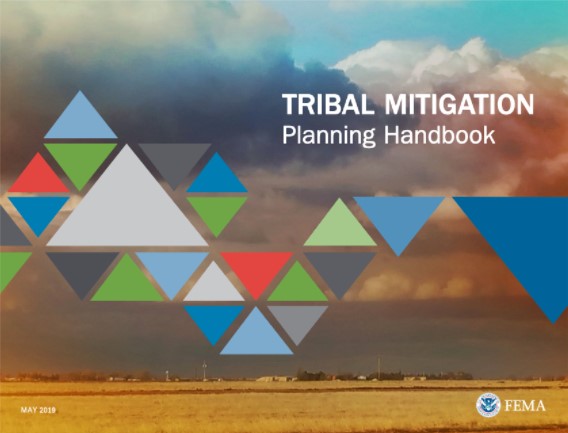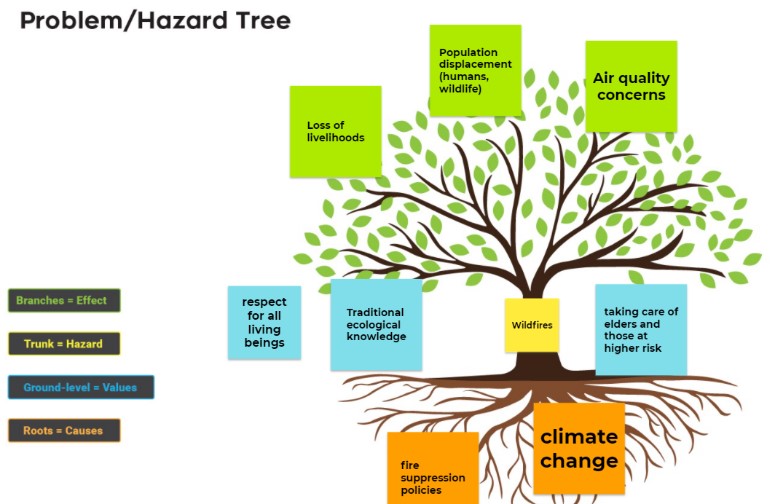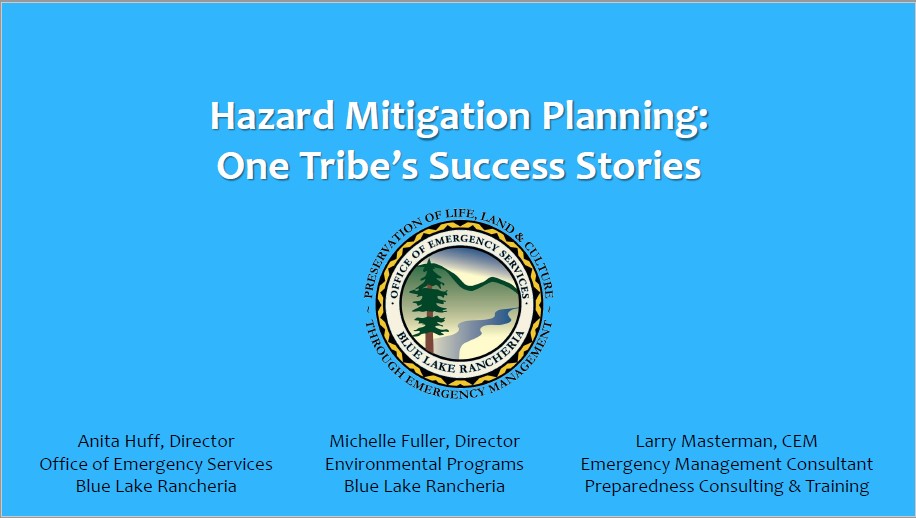Background & Purpose
Climate change is intensifying hazards for communities across the globe. Tribal communities are at the forefront of experiencing extreme weather events and natural hazards.
The Bad River Band of Lake Superior Chippewa are experiencing prolific flooding events, with the most recent and intense flood causing $25 million worth of
infrastructure damage. The Tohono O’odham Tribe is experiencing intensified and
more frequent extreme heat events which is threatening the survival of many of their
traditional foods.
Coupled with extreme heat, the Karuk Tribe is experiencing increased wildfire frequency and severity, threatening their surrounding ecosystems and
cultural practices and ceremonies. These examples barely begin to capture the
climate-driven hazard impacts Tribes are facing. One opportunity to prepare for and mitigate against these hazards is for Tribes to write Tribal Hazard Mitigation Plans (THMPs).
 FEMA’s Tribal Mitigation Planning Handbook Cover
FEMA’s Tribal Mitigation Planning Handbook Cover
According to a
Natural Hazards Center article,
in 2015 only about 21% of federally-recognized Tribes had a Federal Emergency Management Agency (FEMA)-approved hazard mitigation plan. Yet such plans are required to receive FEMA Building Resilient
Infrastructure and Communities (BRIC) funding that can be used for the implementation of mitigation projects to decrease future harm to communities from hazards. In response to interest expressed by
Tribes for considering climate change, culture, and Traditional Knowledges in emergency preparedness and also in an effort to connect Tribes to funding resources, ITEP developed a cohort course. From
October 2020 to September 2021, the Institute for Tribal Environmental Professionals’ Tribes and Climate Change Program (TCCP) hosted a Climate Change 202 course,
Tribal Hazard Mitigation Planning. A
THMP looks "at natural hazards that may affect tribal governments and suggests actions to reduce losses from those hazards"
(
FEMA Tribal Mitigation Planning Resources). The course was based
on FEMA’s hazard mitigation plan requirements to support developing or updating a THMP and was facilitated through a peer-to-peer learning and knowledge sharing model. Approximately 40 Tribes attended at least 40% of the sessions.
This course was created based on requests and suggestions from a previous ITEP TCCP course cohort. The purpose of the course was to connect Tribes to resources to ease the FEMA grant funding, application,
overall planning and submission process for Tribes who are creating their first THMP or were updating existing plans. FEMA mitigation specialists were invited to attend cohort sessions, which gave cohort
members direct access to FEMA representatives to ask questions and gain further insight on the THMP process, as well as establish interpersonal working relationships with these FEMA representatives.
Structure
This virtual 12-month course consisted of three required course hours each month with additional, optional 1.5-hour sessions starting in January 2021. Each month there was 1.5-hour lecture style large-group
meeting given by ITEP facilitators and guest presenters on various hazard mitigation topics. The cohort was divided into two smaller working groups based on which region they are located in. These working groups
met for an additional 1.5 hours each month. The small groups were co-facilitated by Bureau of Indian Affairs’ (BIA) Tribal Liaisons and FEMA mitigation specialists and provided an opportunity to dive deeper into
topics introduced during the large group sessions earlier in the month, as well as receive insight, support, and resources from the course facilitators. Course participants who responded to the course evaluation
indicated that the small group sessions were one of the most beneficial aspects of the course. In addition to the large and small working groups, additional sessions were held at the end of each month including
five hazard focus sessions (wildfire, flooding, drought, pandemics, extreme heat) and one data tools session were held. 86% of responses from the final course evaluation indicated that these additional sessions
were useful for mitigation planning.
 Example of a community engagement activity featured during the retreat
Example of a community engagement activity featured during the retreat
An in-person event was scheduled for the cohort for summer 2021 prior to the onset of the pandemic in March 2020. However, given the shift to virtual events, a virtual retreat was planned for the cohort instead.
The retreat took place over the course of four days in mid-July 2021 with 4.5 hours of content provided each day. Content consisted of presentations, discussions/break out groups, and work sessions focused on community
engagement, data tools, and scenario planning. The retreat included guest speakers from FEMA, Emergency Hound, USGS, NOAA Office for Coastal Management, Alaska Center for Climate Assessment and Policy, and NASA.
sessions focused on community engagement, data tools, and scenario planning. The retreat included guest speakers from FEMA, Emergency Hound, USGS, NOAA Office for Coastal Management, Alaska Center for Climate
Assessment and Policy, and NASA
Course content
The course curriculum was organized into five modules: planning process, risk assessment, mitigation strategy, action plan, and plan progress and implementation.
Topics included within modules
• Natural hazards
• Climate change in the context of natural hazards
• The mitigation phase of FEMA’s four-phases of emergency management (mitigation, preparedness, response, and recovery)
• Cultural considerations
• Inclusion and protection of Tribal/Indigenous Knowledges
• Community outreach and engagement
• Hazard identification and risk assessment
• Asset inventorying
Guest speakers included representatives from
• Cohort members
• Federal agencies
• Academic research institutions
• Tribes with existing THMPs
• Climate Adaptation Science Centers (CASC)
• ITEP
Challenges
The Tribal Hazard Mitigation Planning cohort course sought to address multiple challenges faced by Tribes when planning for hazards. One main challenge is a that often a single person is working on a THMP on behalf
of an entire Tribe. According to an article written by Zambrano et al. (2019) “less than 25% of all Tribal nations have an Office of Emergency Management, and less than 10% of those have full-time emergency managers”
(see also Status of Tribes and Climate Change Report 2021). The cohort was created to provide support to these individuals, as well as accountability so that climate adaptation planning efforts would continue to move
forward. In addition to this overarching challenge, there are many other challenges associated with the THMP process. To start, gathering in-house support within a Tribe to write a THMP bears its challenges because the
Tribe has other priorities such as ensuring the health and safety of community members from COVID-19 and other health related issues, disaster and extreme weather management, etc.
 Presentation slide from Blue Lake Rancheria on working with consultants
Presentation slide from Blue Lake Rancheria on working with consultants
When it comes to putting together the THMP, Tribes run into challenges with hiring consultants to write their plans. Outside consultants are often hired to put together THMPs. However, it is important for Tribes to hire
consultants who engage community members in the planning process and who respect and reflect Tribal values and culture within the plan itself, which can include sensitivity to sacred sites, inclusion of language, and more.
There are also issues generally related to balancing between the limited capacity-driven need to hire consultants to compose THMPs and Tribes being able to direct these efforts and build capacity to do this work for
themselves in the future.
Challenges also exist once plans are completed. Although THMPs provide an avenue for funding to implement hazard mitigation projects, there is typically a need for additional funding for implementation work. Often, outside
grant funding is necessary to fund implementation projects. These grant applications typically require cost-benefit analysis, which can be problematic for Tribes as they are asked to put a price tag on their cultural resources.
There can also be personnel challenges such as having an adequate number of personnel to implement projects and having personnel with grant-writing expertise to access additional funding for these projects. A parallel issue of
personnel turnover causes a discontinuity within the work and plans, making it difficult to transfer knowledge from one person to the next.
Tribal Takeaways
For this course, Tribes participated from a variety of progress levels from gathering information for future THMP work to starting a THMP for the first time to updating existing THMPs. Throughout the course and especially during
the last working group session, participants expressed many takeaways from the course. These takeaways included appreciating the peer-to-peer learning model where Tribes with more developed THMPs shared what worked and what did not
work in their THMP process. Often these types of exchanges took place during the working group sessions, which were also perceived as extremely useful for connecting with other more regionally based Tribes. The small working groups
also provided an opportunity for cohort members to connect and have easier access to FEMA mitigation specialists to bounce plan ideas off and ask technical questions. Conversely, FEMA mitigation specialists expressed that this course
was a great opportunity to learn more about Tribal nations across the country and the climate impacts they are experiencing. Cohort members also found the integration of expert speakers on the different planning aspects extremely helpful.
Tribes have been practicing emergency management and adapting to climate change since time immemorial. Therefore, it is necessary that Tribal sovereignty is respected, and that Tribes are supported by federal and state partners through
increased resources for emergency management planning (Zambrano et al, 2021). The Tribal Hazard Mitigation Planning course was an attempt to support working through the THMP process and provide easier access to federal and state resources
and personnel, to move forward with planning and implementation.
Resources
Building Resilient Infrastructure and Communities (BRIC)
www.fema.gov/grants/mitigation/building-resilient-infrastructure-communities
Publicly available Tribal Hazard Mitigation Plans
https://drive.google.com/file/d/1RUrUXgdn--bExsbYZCvXTMTZxOymmGP/view?usp=sharing
References
Federal Emergency Management Agency Tribal Hazard Mitigation Resources (2021).
www.fema.gov/about/organization/tribes/funding-mitigation-planning-resources
Carter, L. and Peek, L. (2016). Participation Please: Barriers to Tribal Mitigation Planning. Natural Hazards Center. Volume XL – Number 4.
https://hazards.colorado.edu/article/participation-please-barriers-to-tribal-mitigation-planning
Zambrano, L., Byrne, S., Cedeno, J., Pastos, N., Nutter, R., Walsh, W., Akelerea, J., Gutierrez, M., Zendejas, J., Gutierrez, P., McCabe, M., Sundown, E., Pennington, J., Dent, L., Jones, W., Johnson, R., Ostenberg, R., & DesRosier, R. (2019).
Building Cultures of Preparedness with Tribes. Green Bay, WI.
Zambrano, L., Cooley, C., Crow Ghost, D., Cruz, M., Hardison, P., Hingst, P., Jones, C., Maldonado, J., Marks-Marino, D., & Tangen, S. (2021). Emergency Management. In Status of Tribes and Climate Change Report [Marks-Marino, D. (ed.)]. Institute
for Tribal Environmental Professionals, pp. 222–240.
This profile was developed in 2021 by Kelsey Morales, Institute for Tribal Environmental Professionals, Northern Arizona University, with financial support from the Bureau of Indian Affairs. The profile is available on the Tribes & Climate Change website:
. The tribal climate change profiles featured on the website are intended to be a pathway to increasing knowledge among tribal and non-tribal
organizations interested in learning about climate change mitigation and adaptation efforts.
Special thanks to the 2020-2021 Tribal Hazard Mitigation Planning cohort, our partners at the Federal Emergency Management Agency (FEMA) and the BIA Tribal Liaisons for participating in the course, as well as Julie Maldonado for her assistance in developing this profile.
Citation: Morales, K. (November 2021) Climate Change 202: Tribal Hazard Mitigation Planning Cohort. Climate Change Program, Institute for Tribal Environmental Professionals, Northern Arizona University.
Available at:
 FEMA’s Tribal Mitigation Planning Handbook Cover
FEMA’s Tribal Mitigation Planning Handbook Cover
 Example of a community engagement activity featured during the retreat
Example of a community engagement activity featured during the retreat
 Presentation slide from Blue Lake Rancheria on working with consultants
Presentation slide from Blue Lake Rancheria on working with consultants